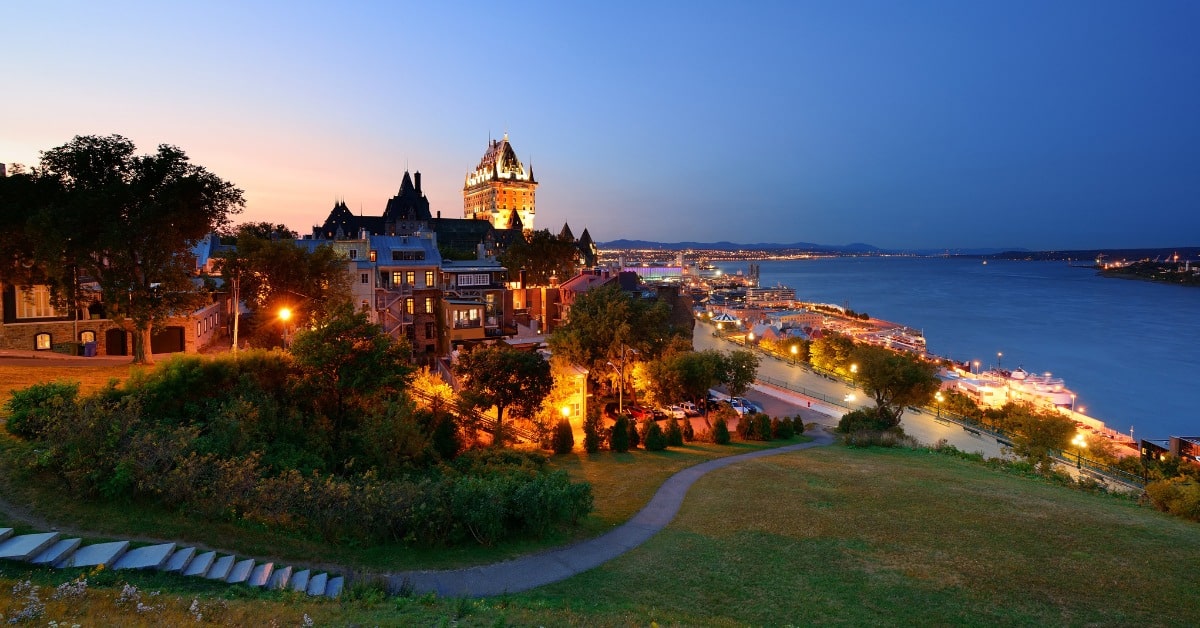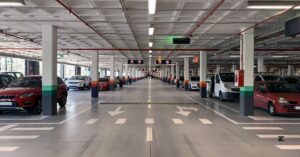Quebec City is a delight for anyone’s eyes and palate. I had three days there recently and had a wonderful time eating my way through the city.
Undoubtedly, the finest hotel in Quebec is the Fairmont Chateau Frontenac located in the heart of Quebec’s historic walled city. Built in 1893 and the site of famous Quebec Conferences during World War Two it is even a dog friendly hotel. Indeed you can take your pet to the Chateau and it can stay in your room. There is a pet ambassador at the Chateau known as Santol, as the resident dog at the hotel is called. He often can be found in the lobby beside the desk of the concierge.
The first restaurant I visited was called Le Continental, and it was a marvel of quiet elegance. I feasted on Filet Mignon, which was served flambé at the table by several of the waiters. The food was wonderful.
The next day I had lunch at Le Cafe du Clocher Penche and it was amazing. The atmosphere was simple. Clean lines and wood tables are the visual motif. The food was uniformly excellent, rich pates and carefully prepared entrees were the order of the day. This is one of those restaurants where not only is the food excellent but great attention is paid to the manner in which it is presented.
Also Read
I met the chef, Mathieu Brisson, who describes his kitchen method as bistronomy, a way of elevating bistro food to new heights in an attempt to bring forward every bit of flavor from whatever is served. Mathieu says, “We try to bring it up a level but not too much. It needs to be simple. We don’t take shortcuts. It’s the way it should be.” I think he is very successful.
Across the street from Le Clocher is Le Cercle, which is another find. They have a wonderful and highly eccentric owner, Frederic Poitras. “We have a very open policy. Someone comes in and says, ‘I have fifty dollars, and I want four courses.’ We say OK, and they realize that they will get whatever the chef thinks is good at the moment. Another difference is that we seat people unusually. We put baby boomers with people in their twenties. We do things like that, and we are finding that it works! All people are blended by age.”
This is a venue for open-minded people, a very unusual place, to be sure. It’s eccentric and has a stage next door to the restaurant where people put on shows.
That evening, I went to L’Initiale, a restaurant built into a building that was formerly a bank. This is one of the most famous restaurants in Quebec City. In the kitchen, the money vaults are used to refrigerate. Nothing is wasted here. Chef Yuan Lebrun says, “I’m bored when I’m not creating.” He constantly innovates with his menu and constantly brings new ideas to his guests.
Yuan’s wife, an admirer of her husband’s cooking, manages the service, which is excellent. Everyone is dressed in waist-length dinner coats; nothing is missed in this very bankable experience.
The next day, I had dinner at a most unusual restaurant. It was a six-course meal made by an American chef on a Huron (Wendake) Indian reservation. It was the first time I ever ate seal, a delicacy that tasted like a cross between fish and cow’s liver.
The restaurant also houses a museum of Wendake’s life, a hotel, and a very congenial restaurant. It must be the 21st century because the man sitting next to me at dinner, Jason Picard-Binet, who works for the hotel, began talking about the Wendake app. I was startled by my anticipation of the meal, and I came flabbergasted. Among the things I ate was “Face Cacheé de la Mer,” a dish of raw salmon in a sour glass wort sauce, which was described by a neighbor: “It’s like Salmon candy!” Somewhat later, we ate elk tartare, which was quite tasty, had a surprisingly mild taste, and went down easily.
Somewhere between the fourth and the fifth course two Indian women brought a drum behind our table and began beating it and singing and dancing. All of which was pretty wonderful.
The next day, I traveled to Orleans Island across the St. Lawrence River from Quebec City. It is twice the size of Manhattan, 25 miles long by 5 miles wide, full of farms that supply much of the produce that fills the tables of its neighbor across the water. There are also microbreweries and vineyards.
Among the vineyards is Cassis Monna et Filles. A native of Southern France and a Generation Liquoriste, Bernard Monna was the first to produce black currant wines and Creme de Cassis in Quebec. He first arrived on the Ile d’Orleans in the early ’70s and settled into the area. He found that the spot on the map boasted the ideal microclimate for growing black currants. Cassis Monna &Filles currently cultivates 5 hectares of land and produces 30,000 bottles per year.
A little further along the central road is Fermé au gout d’autrefois, an organic restaurant.
It is built into a two-hundred-year-old house at 4311 Chemin Royal (418-829-9888) and run by its owners, Jacques Legros and Lise Marcotte, a married couple. Upon entering, I saw turkeys and chickens standing near the door and learned that the restaurant has a very humane policy about slaughtering animals and giving them freedom on the property. The food was great, and I’m sure that if you are looking for an organic dinner, you will not be disappointed.
What is Quebec City Best Known for?
Quebec City is best known for its rich history, European charm, and well-preserved architecture. As one of the oldest cities in North America, Quebec City offers a unique blend of French heritage and modern Canadian culture.

Here are some of the key aspects that Quebec City is renowned for:
- Old Quebec (Vieux-Québec): This historic district, designated a UNESCO World Heritage Site, is the heart of Quebec City. It’s known for its cobblestone streets, 17th- and 18th-century architecture, and fortified walls—the only remaining fortified city walls in North America north of Mexico.
- Château Frontenac, often hailed as the most photographed hotel in the world, is a testament to the grandeur and beauty of Quebec City. With its stunning architecture and breathtaking views of the St. Lawrence River, this iconic landmark is a must-visit spot.
- Citadel of Quebec: This historic military fortress, part of the city’s fortifications, offers guided tours that delve into the history of Quebec City and Canada’s military past.
- Winter Carnival (Carnaval de Québec): Quebec City hosts one of the world’s largest and most famous winter carnivals. The event features ice sculptures, parades, and traditional Canadian winter activities like ice canoe racing.
- French Heritage and Culture: As the capital of Quebec, the only predominantly French-speaking province in Canada, Quebec City is deeply rooted in French culture. Visitors can experience authentic French cuisine, art, music, and traditions throughout the city.
- Festivals and Events: Quebec City is known for its vibrant festivals and events, including the Festival d’été de Québec, a major music festival, and the New France Festival, which celebrates the city’s colonial history.
Quebec City is best known for its historical significance, European-inspired architecture, and unique cultural experiences that attract visitors worldwide.
The trip to Quebec was wonderful. Nice people, great food, and a truly foreign destination; I’d go back in a heartbeat.






